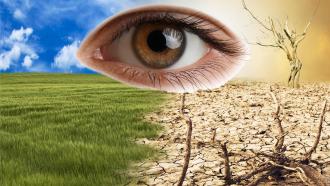Photo: Siddharth Kankaria / Research Matters
On a pale blue dot, after years of evolution, arrived organisms that could walk upright. Although related to chimpanzees, these organisms had advanced cognitive skills that they utilized to invent tools and techniques to suit their needs. It started with the invention of stone tools, followed by agriculture, big industries and empires. These organisms, us, the Homo sapiens, triggered a chain of development that has changed the pale blue dot, our planet Earth, in countless irreversible ways.
One indicator of that transformation is the rising global average temperature. According to the US National Oceanic and Atmospheric Administration, all sixteen years of the twenty-first century rank among the seventeen warmest years on record. The rising temperatures result in melting glaciers at the poles, raising sea levels, damaging marine life and eventually throwing the ecological and atmospheric balance out of gear.
To observe the effects of climate change, one need not go the poles to see the melting glaciers and ice caps. The situation closer home offers a good example. Mr. Arunabha Ghosh, Chief Executive Officer of India’s Council on Energy, Environment and Water, an environmental group, explains, “floods previously considered to be one-in-100-years events could occur ten times a year by 2020 – a time when India is set to become the world’s most populous country.” The Kedarnath floods in 2013, Chennai floods in 2015 and Varanasi floods in 2016 have already set the pace. Besides floods, record breaking heat waves and droughts have become a regular occurrence. As environmental degradation continues to escalate, the situation is set to become worse.
The increasing degradation is reflected in the greenhouse gas emissions, which show that India is the fourth largest greenhouse gas emitter, accounting for 5.8% of global emissions. To add to the woes, 22 of the world’s most polluted cities are in India, with New Delhi being the most polluted Indian city, as documented in the World Health Organization’s ‘World Ambient Pollution Database – 2016’. The increasing air pollution in Delhi came to fore last year when schools throughout the Delhi-National Capital Region were shut for three days due to smog – a deadly mixture of smoke and fog.
But there is a ray of hope lurking amongst us. The home to some of the world’s most polluted cities – India – also harbours Asia’s cleanest village! Nestled in the beautiful north-eastern India, Mawlynnong village in the state of Meghalaya is bestowed with the proud tag of being ‘Asia’s cleanest village’. While most of us cringe at the idea of cleaning our rooms, this is a place where people voluntarily clean streets. The villagers take turns to sweep roads and lanes, water plants in the public area and even take turns to clean drains! Polythene and smoking are completely banned, cutting out all traces of toxin wastes.
As a first step towards protecting our environment, we could follow Mawlynnong village’s example of keeping our surroundings clean. The good old deeds of properly discarding waste, recycling, planting a sapling, using public transport, could be adopted. We of course do not want to live in filthy and unhealthy surroundings, do we?
Just like us, millions of other organisms on this planet would not like to live in an unhealthy environment we have created for them. A report from last year shows that an area twice as big as Alaska has been tarnished by human activities between 1993 and 2015. Consider this -- the Great Barrier Reef, world’s largest coral reef system and the biggest single structure formed by marine animals, is now on the brink of extinction, thanks to us! Scientists predict a scary future with as many as 30-50% of all species possibly heading towards extinction by mid-century.
In our maddening frenzy of development, we have forgotten that we share this planet with innumerable plants, animals, birds and microbes. The mass extinction we are causing on this planet is eventually going to affect us, for our survival depends on those plants and animals we never cared for. We rely on trees for storing all the extra carbon we release, on bees to pollinate flowers and keep the plants alive, on the bacteria in our guts to digest our food, and countless other animals and birds, which together maintain and sustain the ecosystem, of which we are only a tiny part. Neglecting the rest of the ecosystem in the rush to develop is like carving a path for our own extinction.
The theme for this year’s World Environment Day is ‘connect with nature’. Step out of and explore the beauty and importance of nature on this planet. As organisms with advanced cognitive skills, we have more than an obligation to preserve our very own pale blue dot, before it is too late.






